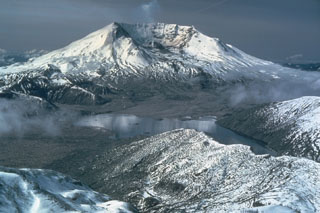Report on St. Helens (United States) — November 1981
Scientific Event Alert Network Bulletin, vol. 6, no. 11 (November 1981)
Managing Editor: Lindsay McClelland.
St. Helens (United States) Dome expands slowly; rock avalanches
Please cite this report as:
Global Volcanism Program, 1981. Report on St. Helens (United States) (McClelland, L., ed.). Scientific Event Alert Network Bulletin, 6:11. Smithsonian Institution. https://doi.org/10.5479/si.GVP.SEAN198111-321050
St. Helens
United States
46.2°N, 122.18°W; summit elev. 2549 m
All times are local (unless otherwise noted)
Measurable downslope movement of the new lobe extruded onto the composite lava dome (figure 20) had ended by 4 November. Distance measurements from fixed points on the crater floor to laser targets on the dome showed that very slow expansion of the entire dome continued through November. As of late November, the rate of expansion was stable at roughly 0.25-0.33 cm/day. No movement occurred during November along any of the small thrust faults formed in the crater floor by past expansion of the dome, nor was there any measureable outward movement of the N crater rampart. Gas sampling was infrequent because of poor weather, but no significant changes were evident in the rate of SO2 emission.
During November, seismic instruments recorded 54 earthquakes in the Mt. St. Helens area (some were aftershocks from the Elk Lake earthquake of 13 February; SEAN 06:02), a typical level of seismicity for a month without an extrusion episode. The largest event was slightly stronger than M 1. Many of the earthquakes resembled steam plume or rock avalanche events, but weather conditions prevented visual confirmation. Medium-frequency events with sharp arrivals, similar to some of the August and early September earthquakes, were recorded at a rate of about 1/day in early December.
A series of seismic signals that indicated rock avalanching in the crater began with isolated 30- to 45-minute periods of seismicity late 4 December. Activity peaked the next day, with 14 events of more than 45 seconds duration between 0930 and 1800, the longest a 220-second episode beginning at 1253. Seismic instruments continued to record occasional rock avalanche events during the night of 5-6 December. As of press time, weather conditions had prevented observations of any changes that may have occurred in the crater. None of the December rock-avalanche events were as large as the seismic signal from the 2 October avalanche that deposited as much as 7 m of debris in the S part of the crater.
Geological Summary. Prior to 1980, Mount St. Helens was a conical volcano sometimes known as the Fujisan of America. During the 1980 eruption the upper 400 m of the summit was removed by slope failure, leaving a 2 x 3.5 km breached crater now partially filled by a lava dome. There have been nine major eruptive periods beginning about 40-50,000 years ago, and it has been the most active volcano in the Cascade Range during the Holocene. Prior to 2,200 years ago, tephra, lava domes, and pyroclastic flows were erupted, forming the older edifice, but few lava flows extended beyond the base of the volcano. The modern edifice consists of basaltic as well as andesitic and dacitic products from summit and flank vents. Eruptions in the 19th century originated from the Goat Rocks area on the N flank, and were witnessed by early settlers.
Information Contacts: D. Swanson, USGS Cascades Volcano Observatory (CVO), Vancouver, WA; C. Boyko, S. Malone, E. Endo, C. Weaver, University of Washington; R. Tilling, USGS, Reston, VA.


